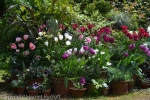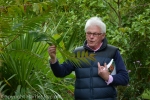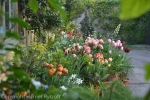I went a bit viral on Twitter this week. Not for a witty remark or a 240 character piece of incisive social commentary. Certainly not for a stylish look that everyone would want to copy. No, I was the mad old lady with hair so messy a newly fledged goldcrest chick didn’t want to leave it. If only I had brushed my hair before heading out to weed the garden! Anyway, it has been very popular, so I thought I’d give you some background…
We have always had goldcrests in our garden. Goldcrests are the smallest bird in the UK. And I mean RIDICULOUSLY small. They weigh about 5g (a quarter of an ounce). I hear them all the time when I’m gardening, their thin little contact call is like a tiny hinge squeaking and I have wasted many hours trying to get a clear photograph of one but they are so small and so quick! This week I got a bit closer to them than I had intended.

Predator 2. This is the best photograph I’ve ever managed to get of a sparrowhawk in our garden. It had killed such a fat wood pigeon it didn’t want to leave it.
Lots of birds use our garden, I don’t put food out because we have an evil cat and there are many cats who come to fight with her and claim the right to kill things here. Nevertheless we have robins, wrens, thrushes, long-tailed tits, coal tits, great tits, blue tits, tree creepers, nuthatches, blackbirds, sparrows, starlings, jackdaws, great spotted woodpeckers, goldfinches, dunnocks, chaffinches, collared doves, wood pigeons, greenfinches, chiffchaffs and sparrowhawks here regularly, I suspect many nest in our trees and shrubs. The sparrows, starlings and jackdaws use the house. Sometimes tits and robins do too.
It’s not huge, it’s a town garden, but we are lucky enough to have a wide range of trees, from big, dense Chamaecyparis and other conifers to a silver birch, a mountain ash, an old apple tree, a crab apple, an Amelanchier and a massive 150-year-old yew tree. The yew tree is between our concrete yard and the main garden. The flowerbeds are densely planted and the garden gets wilder and messier towards the far end. I’m a professional gardener and I think people often expect our garden to be like a show garden but it is very scruffy. I lavish time and attention on the pots by the house (about 300 of them…) but the rest of the garden has to fend for itself for long stretches of time as I refuse to be a slave to it, as a result the further you get from the house the more bindweed and nettles you will see.
I leave a large patch of the lawn to grow long until late summer and although I mow the rest of the lawn I never use weedkiller or fertiliser on it, as a result the grass is full of clover, buttercups, self-heal, bird’s foot trefoil, vetch, dandelions and other goodies. I don’t mind as long as it looks greenish. I reckon the wildlife has increased greatly since I started leaving long grass, I haven’t surveyed it properly but we have noticeably more moths, a wide variety of bees and lots of other little flying/crawling things I can’t identify accurately.
I don’t use pesticides on my plants any more, I used to spray for aphids occasionally but now I only squash them if they are overwhelming something delicate. I squash lily beetles and spanish slugs because nothing seems to eat them, I use some “organic” slug pellets sparingly around the few delphiniums I have in early spring and a few around the dahlias I grow in pots, but otherwise I have stopped using them. Snails go on a trip to the compost heap and I’m sure they come straight back, but it takes them a while. We have a little overgrown pond too, and get frogs, toads, newts and grass snakes. But that’s another story.
For me little encounters with wildlife – whether birds, hedgehogs or beetles – are a large part of the pleasure of gardening. I’m lucky to have my own little patch and to work in other gardens as well, but the goldcrests are one of my favourites. I was very excited when I spotted the first goldcrest nest I’d ever seen this spring. It dangled from the end of a yew branch only about 3 feet above our heads by the gate onto the lawn and I wouldn’t have noticed it at all if it hadn’t been for the fact that I was trying to photograph the goldcrests and suddenly realised they kept going back to the same branch. They were busy bringing beakfuls of aphids to a nest not much bigger than a tennis ball, stitched into the yew twigs with cobwebs, coated with moss and lichen and lined with hair and feathers.
A week or two later the nest was silent and I worried that the jackdaws had found it in the same way they found the long-tailed tits’ nest this year. But no! The babies were being fed in the laburnum down at the wilder end of the garden. I counted about five (even the babies don’t keep still for long) and was ecstatic.
A couple of weeks ago I realised that they were at it again! I was planting pots next to where we park our car and once again heard the thin squeak. The adult birds seem to squeak every time they move to a fresh perch and it takes a while to spot them as the noise is so small and high it is hard to tell where it’s coming from. Sure enough their little tweezer beaks overflowed with little legs, wings and the squidgy ends of tiny caterpillars, and a new mossy tennis ball dangled right above my head.

Birds’ eye view – looking down from the second nest. Don’t worry, I took these photos after everyone had gone.
At first I couldn’t hear the babies, but as the days went by the squeaks from the nest got louder and louder. I worried that the jackdaws would notice but I also wondered if the goldcrests were deliberately nesting so close to human activity because the jackdaws, woodpeckers and sparrowhawks were less likely to have the nerve to bother them there. I know proper biologists hate it when we attribute human motivations to animals, but birds, even tiny ones, are clever.
On Wednesday this week the noise from the nest was so loud it was audible inside the house. I went out and peered up – I could see little heads poking out. How many were there? I couldn’t see more than five at any one time but I know it is possible for those nests to contain a dozen babies. The adults were frantically rushing back and forth to stoke the gaping mouths and I spent an hour or so up a ladder about 15 feet away taking photographs. The babies were fighting for space, squeezing between their siblings and balancing precariously on the edge to poo outside the nest. When they were smaller I had seen the parents taking faecal sacs away from the nest but now the children were potty-trained there was more time for food gathering. The adults looked ragged now, the female had a wound (from a cat?) on the back of her neck, but she flew back and forth tirelessly, bringing tiny insects to alternate sides of the nest, stopping only to tidy up the odd stray feather.
Once or twice, in the competition to get best feeding position, a fledgling nearly fell out and I was relieved to see that their wing feathers were well developed. But what would happen when they finally emerged? I checked that the cat was asleep upstairs and shut the door – she doesn’t often bother with birds, but a new fledgling will tempt even the fattest, laziest cat. When I went in for lunch I told my husband and younger son that the babies would be out soon. They showed just enough interest to humour me and went back to discussing our son’s purchase of a second hand car for his impending move to a house in Birmingham now that he has completed his degree.
After lunch I went out to do some more gardening and there was a minuscule fledgling on the gravel. I scooped it up and put it on top of the hedge – our cat was indoors but there are plenty more around. I went to fetch my secateurs, came back out and found another, fluffier one just hopping between car and pots. I called the others to see it, took some photos, then scooped it up and put it on the hedge. I went into the garden and carried on weeding. By the time I went back for a glass of water I could hear several in the shrubs round about, I should think about eight flittered down that afternoon.
I walked carefully across the yard because the fledglings were not much bigger than a piece of gravel and it would be so devastatingly easy to crush one. Another one scuttled under the car. I scooped it out and instead of flying obediently to the hedge it hopped straight up my tee shirt and onto my head! Those tiny little feet are very grippy. I could hear it chirping and fluttering like a moth. I called my husband. No answer. I used my phone in selfie mode to see what was going on and laughed out loud. I pressed record because when am I ever going to have a goldcrest fledgling hopping about on my head again? After 3 minutes of gentle persuasion he eventually flew off to the hedge. I showed the video to my son, who laughed politely and carried on packing his suitcase.
I left my phone in the house, uploading my amusing little film to Twitter (I like to tweet birds, it’s only right). Little did I know that my Edward Lear-ish predicament would strike such a chord with so many people.
Eventually the chirping was silent except for a couple of little voices from the nest. Oh no, I thought, the slowcoaches have been left behind! At last their excited squeaks told me they were still being fed, while, hopefully, their more advanced siblings had been led away safely. The next morning the last two left after breakfast and the nest is now silent and empty. This morning my youngest son packed his belongings in his new car and set off for Birmingham.
Good luck, all of you.



























I saw this on twitter last evening and retweeted, not putting 2 and 2 together until your blog entry landed in my email today, that I followed your blog. Brilliant video and I love the story to complete the fledglings’ adventures.
LikeLiked by 1 person
Yes the Twitter thing was a bit of a wild ride, glad to say it has subsided a bit now! Glad you enjoyed the whole story 🙂
LikeLiked by 1 person
Wonderful to be able to capture these pictures.
LikeLiked by 1 person
Thank you Brian, yes I’ve been very lucky.
LikeLike
So happy found your tweeting video via Tom Cox (The Good, Bad & Furry). Sharing your garden with feathered friends & concern over them makes me feel not quite so odd. I get caught up with wildlife living about small home. Quite enjoy your gardening style, welcoming & comfortable.
LikeLike
Thank you DeeAnn, I’m glad you enjoyed it, I think there are quite a lot of us odd people!
LikeLike
Harriet, this is absolutely the best blog I have ever read. Your consideration for habitat has certainly enhanced your beautiful garden and oh my, what a wonderful experience it has given you. Thankyou for sharing.
LikeLike
Thank you Suzanne, what kind words! Yes it was lovely and I’m glad to be able to share it.
LikeLike
A brilliant story, good luck to everyone leaving home!
LikeLike
Thank you! I saw the male goldcrest in the yew tree yesterday. He was singing quietly to himself and sounded like he was humming contentedly as he pottered about now everything’s calmed down.
LikeLike
It was an amazing video! Great blog too. Lovely photos. 🙂
LikeLike
Thanks Ian!
LikeLike
Thank you for your thoughtful and memory stirring posts I enjoy reading your posts very much. My fledgling left the next five months ago so I know where you’re at. x
LikeLike
Thanks Syrah, glad you enjoy my blog. Yes saying goodbye to our own fledglings is bittersweet!
LikeLike
That video is still making me laugh – and the story of the nest and the babies is lovely. All that wildlife and you don’t even feed the birds. Is there a lesson there? Bit of a gulp at the last bit – babies leaving and all that. Best wishes for 2018, Julie Q
LikeLike